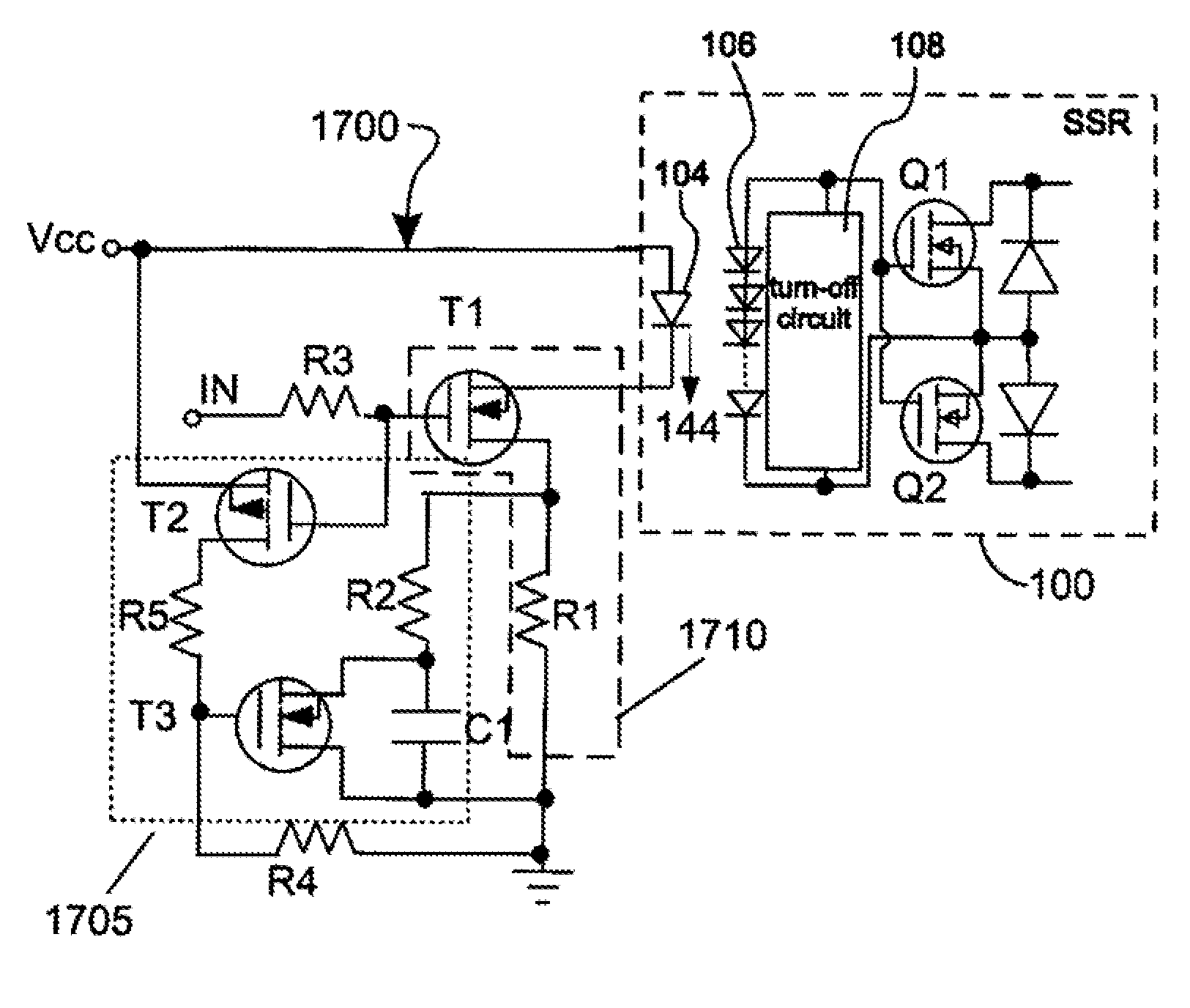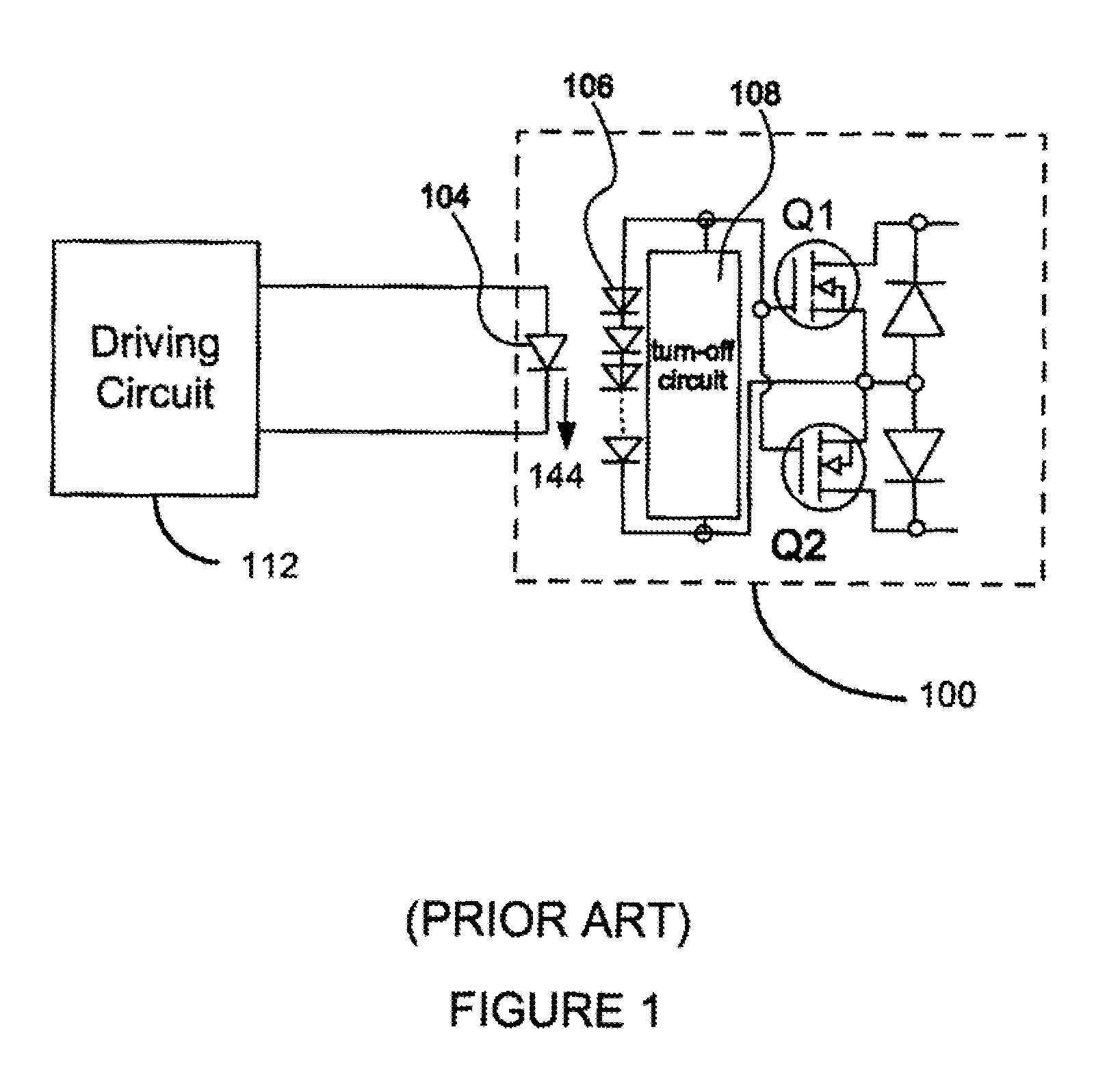Energy saving driving circuit and associated method for a solid state relay
a driving circuit and solid-state relay technology, applied in the direction of optical elements, pulse techniques, instruments, etc., can solve the problems that the used methods of driving ssrs require a significant amount of energy, and achieve the effect of reducing the overall energy required, maintenance or holding curren
- Summary
- Abstract
- Description
- Claims
- Application Information
AI Technical Summary
Benefits of technology
Problems solved by technology
Method used
Image
Examples
first embodiment
5.1 First Embodiment
[0081]FIG. 5 illustrates an exemplary driving current circuit 500) according to one embodiment. In accordance with the present embodiment, selected circuit branches of a driving circuit are connected or disconnected at appropriate intervals to achieve an energy savings over conventional driving circuits. Each branch having a different impedance. By removing a selected branch at an appropriate time, the LED is maintained in an “on” state, while requiring less current than is supplied in a conventional driving circuit.
[0082]Circuit Configuration
[0083]Referring now to FIG. 5 each of the two sub-circuits 501, 503 have different impedances. When connected to the LED, they each form current loops with the LED. One of the sub-circuits, 501 (503), is used to generate the turn-on current and the other sub-circuit 503 (501) is used to generate the holding current. To allow the turn-on current to be much higher than the holding current, the resistance in one of the sub-circ...
first embodiment (
A. First Embodiment (Sub-Circuit)
[0086]A timing diagram for describing this process is shown in FIG. 6a.
[0087]The resistance of sub-circuit 501 is R1 and the resistance of the sub-circuit 503 is R2. It is assumed that R1 is much larger than R2.
[0088]In operation—
[0089]At time t0:—a control signal is applied to the control circuit with both sub-circuit 503 and sub-circuit 501 connected to the LED by the control circuit. The current flowing through the LED is I1+I2, where I1 represents the current flowing through sub-circuit 501 and I2 represents the current flowing through sub-circuit 503. The current I2 is much larger than the current I1 because resistance of sub-circuit 501 is much larger than the resistance of sub-circuit 503.
[0090]At time t1:—Sub-circuit 503 disconnects from LED circuit. At this point, the current flowing through the LED is only I1.
[0091]At time t2:—The control signal is removed. Sub-circuit 501 is then disconnected from the LED. There is no current flow through...
second embodiment
B. Second Embodiment
[0092]A timing diagram for describing this process is shown in FIG. 6b.
[0093]The resistance of sub-circuit 501 is R1 and the resistance of the sub-circuit 503 is R2. It is assumed that R1 is much larger than R2.
In operation—
[0094]At time t0:—A control signal is applied to the control circuit with sub-circuit 503 connected to the LED by the control circuit. The current flowing through the LED and sub-circuit 503 is I2.
[0095]At time t1:—Sub-circuit 503 disconnects from the LED circuit and sub-circuit 501 is connected to the LED. At this point, the current flowing through the LED and sub-circuit 501 is I1. The current I2 is much larger than I1 because resistance of sub-circuit 501 is much larger than resistance of sub-circuit 503.
[0096]At time t2:—The control signal is removed. Sub-circuit 501 is then disconnected from the LED. There is no current flow through the LED and the LED turns off.
PUM
 Login to View More
Login to View More Abstract
Description
Claims
Application Information
 Login to View More
Login to View More - R&D
- Intellectual Property
- Life Sciences
- Materials
- Tech Scout
- Unparalleled Data Quality
- Higher Quality Content
- 60% Fewer Hallucinations
Browse by: Latest US Patents, China's latest patents, Technical Efficacy Thesaurus, Application Domain, Technology Topic, Popular Technical Reports.
© 2025 PatSnap. All rights reserved.Legal|Privacy policy|Modern Slavery Act Transparency Statement|Sitemap|About US| Contact US: help@patsnap.com



